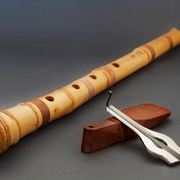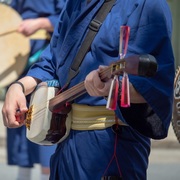You must have heard of Shamisen even if you do not have much knowledge about Japanese musical instruments.
Shamisen is very familiar with Japanese people.
Having said that, how much do we know about Shamisen?
“It has three strings.”
“It is made up of two parts of the “Sao (rod)” and the “Do (torso)”, played by hitting a string with “Bachi (Pick)” held with your right hand, holding a string with your left hand.”
What else do you know?
We know about it, but actually we do not know a lot… Let’s get closer to Shamisen.

Charm of Shamisen
Recently, Shamisen becomes popular abroad too.
Its charm lies in the richness of expression.
While you feel sharp slashing sounds of Bachi (Pick) on outdoor performance, tender and gentle sounds fill the space such as Ozashiki (banquet room).
It can be said that Shamisen is a rare musical instrument which has both extreme tones, bold and delicate.
History of Shamisen
The origin of Shamisen was said to be in Persian or Tibet, but there was no clear fact about it.
As one of accepted opinions, the musical instrument born in the Gen period of China, “Sangen”, was introduced to Ryukyu, which was improved to the traditional musical instrument “Sanshin”, which has played in Okinawa even today.
Sanshin spread to the mainland of Japan in the middle of 16th century, and was improved to the current form of Shamisen.
Sanshin has the Dou (torso) covered with snake skin, and is played by hitting with the nail made from horns of water buffalos.
In the time of Ryukyu Kingdom, it was used for court music, but since the Meiji period(1868-1912), it has spread among ordinary people, then it has now become an essential musical instrument for folk music of Okinawa.
On the other hand, snake skin is not used for Shamisen’s torso.
Generally, it is said that cat skin is used for it, but actually not only cat skin, but dog skin has used for long time.
Recently, artificial leather has also applied.
As you could not find as large snake as that in Ryukyu, it was not be able to use snake skin for Shamisen.
It would be also the same reason why the nails made from horns of water buffalos are not used.
However, why was “Bachi (Pick)” introduced to Shamisen performing?
It is widely accepted as the reason that Biwa hoshi (lute priests) was the first person who used Shamisen.
The history of Biwa (lute) was old, which is shown from that fact the lute called “Raden Shitan no Gogen Biwa” was housed in Shoso-In, Todaiji Temple in Nara.
In the mainland, there were lute players for a very long time, and they used Bachi (Pick) to play, which made Biwa hoshi introduced Shamisen as a musical instrument played with Bachi.
The current form of Shamisen was completed in the Edo period(1603-1867).
Shamisen came to be used for stage music in “Kabuki”, “Bunraku” and “Ningyo Joruri”, which were entertainment for people at that time. Then it gained the popularity as ordinary people’s music.

Then, it came to be the instrument for various genres such as “Tokiwa-zu”, “Nagauta”, “Sokyoku* Gasso”, which led to the current culture.
*Sokyoku: Songs played by Koto (Japanese harp)
Styles of Shamisen
There are mainly 3 styles of Shamisen with different functions.
Futozao (Thick Neck Size): Used for Tsugaru minyo (traditional folk song). It can create powerful sounds even outdoor.
Chuzao (Medium Neck Size): Used for Kouta (geisya music) and minyo.
Shinnai: Improved to ensemble with So (Japanese harp), Shakuhachi (Japanese flute) as such.
Hosozao (Thin Neck Size): Widely used for school training and beginners.
It sounds like only the differences among the sizes of necks, but actually it is more than that.
The thicker the neck is, the bigger the torso gets.
With a bigger torso, the sounds get bigger and the pitch lower.
Indeed, the accessories differ from each style of Shamisen.
Bachi (Pick) for Tsugaru Shamisen, with which high tempo music is played, has the small tip, and Gidayu Shamisen is Futozao (thick neck size) like Tsugaru Shamisen, but is played with a bigger and heavy pick to perform an accompaniment to Joruri.
Also, “Yubikake (Finger guard)” for it is wider than that for other Shamisen to have smoother movement of a pick.
For Kouta by Nakazao, pick is not used.
Extremely small pick is used for high-pitched sounds of Shinnai-bushi*.
*Shinnai-bushi: One of Joruri schools
Jiuta (traditional songs) of Sokyoku is played with a pick with wide tip.
This pick is the biggest among all, and called as “Tsuyama Bachi”.
Thus, the size of torso varies from its size of neck, but accessories are to be chosen by the use of Shamisen.
Shamisen needs higher specialization and has richer characteristics than other musical instrumentals, which leads to be particular about the details.
How to learn Shimisen?
Recently, you can learn many things online or by DVDs.
However, it may be hard to apply to Shamisen.
For Shamisen playing, you need to understand subtle shades of meaning and unique pause which are not instructed on scores. A little act of techniques can decide qualities of sounds.
The way of holding Shamisen and the posture have big impacts on the qualities of sounds as well as on looks.
Also, each different specialty vary the way of holding pick and playing, which makes it impossible to learn for yourself.
If you think of “learning Shamisen”, first, you decide which style of Shamisen you want to learn, and then look for a teacher from that specialty.
For example, if you want to try the style of Yoshida Brothers, you need to choose Tsugaru Shamisen.
Tsugaru Shamisen is attractive with its gorgeousness and powerfulness.
The style of Shamisen is “Futozao”, which has a big torso.
It is very expensive compared with other Shamisen.
It is better to consider buying your own Shamisen after you try some lessons.
To learn Nagauta and Kouta, you also have to learn singing along with Shamisen.

Some classes teach either singing or playing Shamisen, so you need to confirm with a teacher in advance.
For Sokyoku, 2 major schools of Sokyoku, Ikura-ryu and Yamada-ryu, use different Shamisen, Chuzao for Ikuta-ryu and Hosozao for Yamada-ryu.
Actually, those play different songs.
Jiuyta by Ikuta-ryu is played with a big pick stylishly and Yamada-ryu uses a smally pick called Hirabachi (flat pick) to play energetically.
Having said that, either Chuzao and Hosozao can be used.
If you have any of Shamisen, it is best to talk with your teacher first.
You might not need to buy a new one.
Tips for Japanese Musical Instruments
“So (Japanese Harp)” is not that familiar commonly.
“So” generally means “Koto”.
It is sometimes called as “Wagoto” to differentiate from “Taisho Goto”.
2 major schools of Sokyoku are “Ikuta-ryu” and “Yamada-ryu”.
The main difference between these lies in “Koto-Zume (Koto Pluck)”.
Koto-Zume is put on your fingers when you play Koto. Koto-Zume for Ikuta-ryu is called Kaku-Zume, which is square-shaped and thin.
The sounds played with it are light and gorgeous.
On the other hand, Koto-Zume for Yamada-ryu is called Maru-zume, which is elliptical shape and thick, whose sounds are tender and deep.
It used to be called as “Ikura-ryu in the Kansai (West), and Yamada-ryu in the Kanto (East)”, but both schools have been expanded to the national today under the developed transportation network.
If you are interested in Sokyoku, it is recommended to experience both schools.
Summary
While it seems easy to play it as it has only three strings, Shamisen has deep and complicated characteristics.
Shamisen, the Japanses-made musical instrument, has various charm, so why don’t you try it?
Shamisen may take you to the new world.






